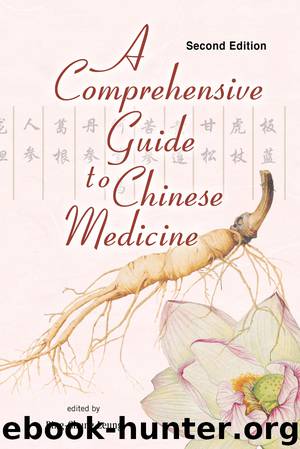Comprehensive Guide To Chinese Medicine, A (Second Edition) by Leung Ping-Chung

Author:Leung, Ping-Chung
Language: eng
Format: epub
ISBN: 9789814667098
Publisher: World Scientific Publishing Company
Published: 2016-03-05T16:00:00+00:00
Chapter 7
Chinese Medicine in China
Ping-Chung Leung
7.1Introduction
Chinese medicine refers to an ancient folk art of the healing developed thousands of years ago in central China, and eventually spread throughout the vast country. It continues to be extremely popular even till today. If Huangdi Neijing (“The Yellow Emperor’s Classic of Medicine”) is considered the classic core knowledge from which other related texts and information are derived, the geographic origin of Huangdi will thus be the centre of development of Chinese medicine. All archaeological excavations and historical deduction acknowledge this centre to be at the historical Zhongyuan (known as the Shenzi–Shanzi region today) (Hoizey and Hoizey, 1988).
Since China is a huge country largely influenced by once-dominating neighbouring powers like the Mongols and Jiangs (now Xinjiang), Chinese medicine of central China was influenced by medical practices from the north-west, west and south-west. The impact from the Arabic region has been brought in from the west; the Silk Route further introduced European concepts and methodology; whereas the south-western boundaries were exposed to Ayurvedic medicine from India (Cant and Sharma, 1966; Farquhar, 1994; Hoizey and Hoizey, 1988; Kleinman, 1975).
The imperial courts and scholars of China are well known for integrating knowledge and information from different sources. Presumably, the wide exposure, the centralisation and subsequent integration of the different streams of ancient medicine created a most comprehensive and sophisticated system of medicine, called Chinese medicine. The system is mastered by a unique philosophical framework which has clear links to ancient philosophers. It is in command of huge volumes of material medica and instruction manuals and documents passed down from generation to generation. The system is not only rich in diagnostics and herbal therapeutics, but also possesses an important section on acupuncture, which is later further developed into a comprehensive system of manual therapy (Anonymous, 475–221 B.C.).
The Chinese employed this system of healing to serve its people for over 3,000 years, since the beginning of human civilisation. It was only when the missionaries arrived China, in the later part of the 19th century that European medicine was brought into China (Wardwell, 1962).
To gain more insight into Chinese medicine today, we must first start from its place of origin (Ernst and Resch, 1995). When European medicine was introduced into China in the late 19th century, the state of the art was still fragmented and did not possess the scientific appeal of subsequent years. Literal writers and scholars of this era used to make fun of these healers in their writings and ridiculed them as being incapable of making a good living (Hoizey and Hoizey, 1988). Later, other writers laughed at their herbal counterparts and regarded them as circus clowns and quacks (Farquhar, 1994) when European medicine became popular.
The most respected healers before the establishment of the People’s Republic of China (PRC), were still the experienced herbalists who inherited the art of healing from a father or a teacher of equivalent repute, while an odd missionary European physician serving in one of the few missionary hospitals in the provincial capitals might be taken as an unusual life saver.
Download
This site does not store any files on its server. We only index and link to content provided by other sites. Please contact the content providers to delete copyright contents if any and email us, we'll remove relevant links or contents immediately.
| Dictionaries & Terminology | Drug Guides |
| Education & Training | Instruments & Supplies |
| Medical Atlases |
When Breath Becomes Air by Paul Kalanithi(7311)
Why We Sleep: Unlocking the Power of Sleep and Dreams by Matthew Walker(5699)
Paper Towns by Green John(4209)
The Immortal Life of Henrietta Lacks by Rebecca Skloot(3859)
The Sports Rules Book by Human Kinetics(3630)
Dynamic Alignment Through Imagery by Eric Franklin(3523)
ACSM's Complete Guide to Fitness & Health by ACSM(3493)
Kaplan MCAT Organic Chemistry Review: Created for MCAT 2015 (Kaplan Test Prep) by Kaplan(3450)
Introduction to Kinesiology by Shirl J. Hoffman(3329)
Livewired by David Eagleman(3172)
The River of Consciousness by Oliver Sacks(3022)
The Death of the Heart by Elizabeth Bowen(2941)
Alchemy and Alchemists by C. J. S. Thompson(2933)
Descartes' Error by Antonio Damasio(2774)
Bad Pharma by Ben Goldacre(2757)
The Gene: An Intimate History by Siddhartha Mukherjee(2523)
Kaplan MCAT Behavioral Sciences Review: Created for MCAT 2015 (Kaplan Test Prep) by Kaplan(2509)
The Fate of Rome: Climate, Disease, and the End of an Empire (The Princeton History of the Ancient World) by Kyle Harper(2465)
The Emperor of All Maladies: A Biography of Cancer by Siddhartha Mukherjee(2462)
